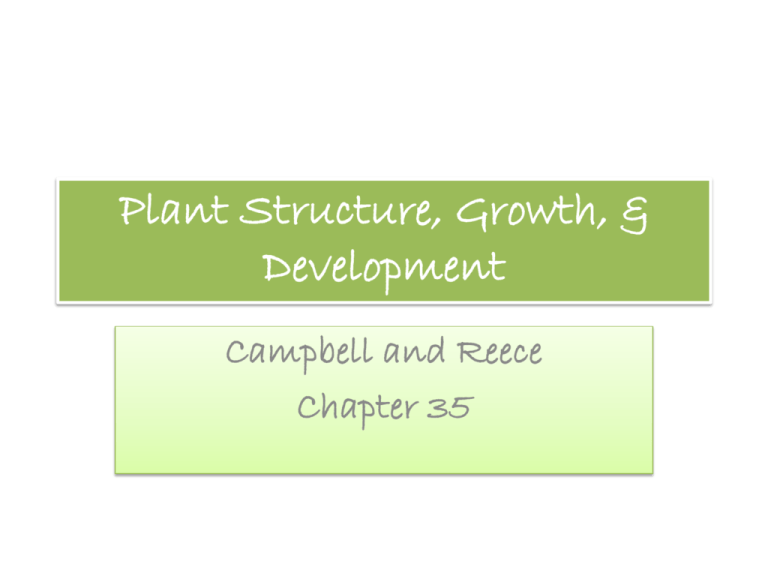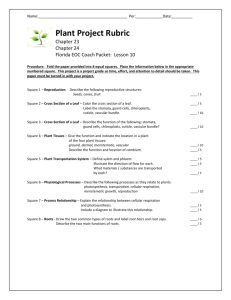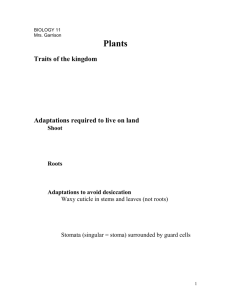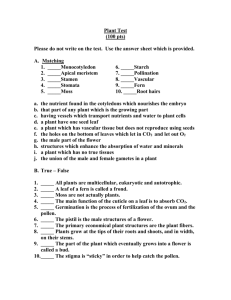Plant Structure, Growth, & Development
advertisement

Plant Structure, Growth, & Development Campbell and Reece Chapter 35 Organization of Plants • Plants like most multicellular organisms have organs made of tissues that are made of different cell types 3 Basic Plant Organs 1. Stems 2. Roots 3. Leaves Roots • Organ that 1. anchors a vascular plant in the soil 2. absorbs water & minerals 3. stores carbohydrates Taproot System • In most eudicots & gymnosperms • Taproot develops from embryonic root • Forms lateral roots (branch roots) • Penetrate deep • Eudicot: most flowering plants that have 2 embryonic seed leaves • Gymnosperm: vascular plant that bears naked seeds Roots in Monocots • Grasses: no tap root • Roots called adventitious: grows in unusual locations – Example: roots arising from stems or leaves Adventitious Root Systems • Each small root forms its own lateral roots fibrous root system Root Hairs • Emerge near tips of roots • Increase surface area for absorption of water and mineral ions (do not help anchor plant) • are thin, tubular extensions of a root epidermal cell Root Adaptations • Prop Roots: support tall, top-heavy trees • Pneumatophores: air roots, portion above water line allows them to get O2 Root Adaptations • Buttress Roots: tallest trees in rain forest have shallow roots; buttress roots give support to trunks • “Strangling” Aerial Roots: seeds of these trees (strangler fig) germinate in branches of host tree Stems • Plant organs that 1. raise or separate leaves allowing them to receive more sunlight 2. Raise reproductive structures facilitating dispersal of seeds or pollen Parts of a Stem • Each stem has alternating system of: 1. Nodes – Pts @ which leaves are attached 2. Internodes – Stem segments between nodes 3. Axillary Bud – Upper angle (axil) formed by each leaf & stem – Structure that can form a lateral shoot (branch) Parts of a Stem 4.Apical Bud – Part of shoot tip – The terminal bud (where most of growth occurs) 5. Apical Dominance – Inhibits growth @ axillary buds – If eaten by herbivore or if light more intense @ side of a shoot axillary buds break apical dominance & grow Why Pruning Makes a Plant Bushier Parts of a Stem Adaptations of Stems 1. Rhizomes: horizontal shoots that grow just below surface ;vertical shoots emerge from axillary buds • Ex: Irises, Hops Stem Adaptations 2.Bulbs: are vertical, underground shoots made mostly of enlarged bases of modified leaves that store food • Ex: onion, tulips Adaptations of Stems 3. Stolons: horizontal shoots that grow along surface; aka “runners” • Enable plant to reproduce asexually: plantlets form @ nodes • Ex: strawberries, some grasses Adaptations of Stems 4. Tubers: enlarged ends of rhizomes or stolons specialized for storing food. “Eye” of potato is cluster of axillary buds that mark the nodes Ex: potato, dahlias Leaves • In most plants leaf is main photosynthetic organ • General Structure: – Blade – Petiole • not on grasses or most monocots – Veins • Patterns differ monocots & eudicots Structure of a Leaf Types of Leaves Leaf Adaptations • Tendrils: modified leaf used to support plant • Ex: pea plants • Some plants have tendrils that are modified stems (grapevines) Leaf Adaptations 2. Spines: leaves adapted for protection In cacti, stems are main photosynthetic organ Leaf Adaptations 3. Storage Leaves: most succulents have leaves adapted to store water Leaf Adaptations 4. Reproductive Leaves: leaves of some succulents produce adventitious plantlets which fall off & take root in soil Ex: some succulents Hens and Chicks Leaf Adaptations 5. Bracts: modified leaves surrounding the real flower; function: attract pollinators The yellow portion of poinsettia is the flower; the red leaves are bracts Tissue Systems • Are functional units connecting all of the plants organs Dermal Tissue System • Plant’s outer protective covering: • Epidermis: nonwoody plants: tightly packed cells • Cuticle: waxy covering on epidermal surface prevents water loss • Periderm: in woody plants: replaces in older regions of stems & roots Vascular Tissue System Carries out long-distance transport of materials between the root & shoot systems 1. Xylem – & dissolved materials roots shoots H2O 2. Phloem – Sugars roots & sites of growth Ground Tissue System • Tissue that isn’t dermal or vascular tissue • Pith: Internal to vascular tissue • Cortex: external to vascular tissue Plant Cells • Cell differentiation involving changes in: – Cell walls – Cytoplasm – Organelles Parenchymal Cells • Mature cells have thin, slightly flexible cell walls (only 1)& large central vacuole • Functions: – Perform most of metabolic functions of plant • • • • Chloroplasts Plastids: store starch, found in roots Make up most of fleshy part of fruits Most able to divide & differentiate into other cell types Collenchyma Cells • Come grouped in strands just below epidermis • Support young parts of plant shoot w/out interfering with growth • Elongated cells with thicker cell walls (compared to parenchymal cells) which can be irregularly thickened • Remain living cells thru out plant life Sclerenchymal Cells • Supportive role but more rigid than collenchymal cells in regions of plant that have stopped growing • 2º cell walls thick, contain lignin (>1/4 dry mass of wood)Lignin in all vascular plants, not in bryophytes • Many dead at plant maturity: rigid cell walls support plant Sclerenchymal Cells • 2 types: (both for support & strength) 1. Sclereids – Boxy, irregularly shaped cells – Thick lignified 2º cell walls – Hardness in nutshells/grittiness in pear 2. Fibers – Grouped in strands – Long, slender, tapered – Hemp fibers for rope/flax fibers for linen Water-Conducting Cells of Xylem • 2 types: both elongated, tubular cells/dead at plant maturity: form tubular conduit for water flow; have pits thru which water can move laterally 1. Tracheids – In nearly all vascular plants 2. Vessel Elements – In some vascular/most angiosperms/few gymnosperms Sugar-Conducting Cells of the Phloem • 4 types all alive @ plant maturity 1. Sieve Cells: in seedless vascular plants & gymnosperms 2. Sieve Tubes: chains of cells/ enucleated, no ribosomes, vacuole, or cytoskeleton sugars can diffuse thru cell more easily 3. Sieve Plates: pores for flow of sap fluid cell-tocell 4. Companion Cells: nonconducting cells connected to sieve tube cells by plasmodesmata/their ribosomes & nucleus serve both cells Growth in Plants Stem Growth Root Growth Cross-Section of a Leaf Anatomy of a Tree Trunk • bark includes all tissues external to the vascular cambian (2º xylem, wood, and phloem) • Sapwood = “living wood” has lighter color than heart wood (center) which is made of dead cells Development of a Plant • Definitions: • Development: specific series of changes by which cells form tissues, organs, & organisms • Growth: irreversible increase in size More Definitions • Morphogenesis:cellular & tissue-based processes by which an organism takes shape, depends on cells responding to positional information from neighboring cells • Differentiation : process by which a cell or group of cells become specialized in structure & function Plant Cell Division • Preprophase band made of microtubules develops in late interphase determines where cell plate will form Asymmetrical Cell Division • not all plant cells divided equally duting M Phase of cell cycle • When occurs: usually signals a key event in development • Example: – Epidermal cell divides • 1 large epidermal cell • 1 small guard cell Cell Polarity • The condition of having structural or chemical differences at opposite ends of an organism • Typical plant has axis with a shoot end & a root end – 1st division of fertilized plant ova asymmetrical which initiates polarization of plant body into shoot & root Cell Elongation • Cell division enhances possibility of plant growth but it is cell elongation that is responsible for plant growth Cell Elongation • Controlled by microtubule orientation controls the orientation of cellulose microfibrils in cell wall Cell Differentiation • Arises from differential gene activation • Enables cells w/in plant to assume different functions • Way any particular cell differentiates depends on its position in developing plant Pattern Formation • Is the development of specific structures in specific locations • 2 hypothesis to explain 1. Lineage-based mechanism – Daughter cells have instructions from early cells in plant development 2. Position-based mechanism – Cell’s position in emerging organ determines what kind of cell it will become Pattern Formation • Position-based hypothesis – By destroying cells during development have shown that cell’s fate determined late in development & depends mostly on signals from neighboring cells – Cell fate in animals mostly lineage-dependent involving transcription factors Pattern Formation • Hox genes – Homeotic genes that code for transcription factors – Critical for proper # & placement of embryonic structures (legs, antennae in Drosophila) Pattern Formation • Knotted-1 homologous to Hox gene found in maize • Important in development of leaf morphology Control of Cell Differentiation • Depends on control of gene expression: which genes are transcribed protein • But fate of a particular cell is determined by its final position in the developing organ, not by cell lineage – If undifferentiated cell is misplaced it will differentiate into cell type appropriate to its position Activation of Genes • Depends on signals from neighboring cells Phase Changes • Cues from plant itself or from its environment cause plant to switch from 1 developmental stage to another: called Phase Changes • Most obvious changes in leaf shape & size Genetic Control of Flowering • Flower formation involves phase change from vegetative growth reproductive growth • transition triggered by: 1. – 2. – Environmental cues Length of daylight Internal signals Plant hormones Genetic Control of Flowering • Production of a flower by a shoot apical meristem stops the primary growth of the shoot • Is ass’c with the switching on of floral meristem identity genes • Meristem: plant tissue that remains embryonic as long as plant live, allowing for indeterminate growth Meristem Identity Genes • Code for transcription factors that regulate genes needed for conversion of the indeterminate vegetative meristems determinate floral meristems Organ Identity Genes • A plant homeotic gene that uses positional information to determine which emerging leaves develop into which type of floral organs Organ Identity Genes • Provide model system for studying pattern formation: – The development of a multicellular organism’s spatial organization: arrangement of organs & tissues in their characteristic places in 3-D Organ Identity Genes • 3 classes identified by studying mutants with abnormal flowers • ABC Hypothesis • A model of flower formation identifying 3 classes of organ identity genes that direct formation of the 4 types of floral organs • http://www.slideshare.net/jayswan/chapter35-presentation









